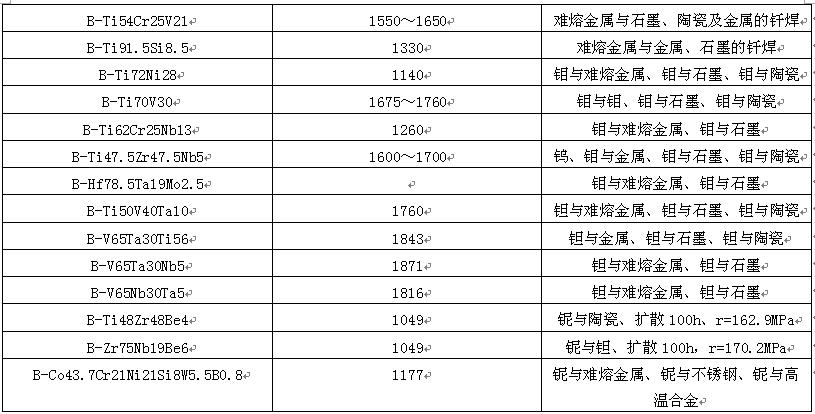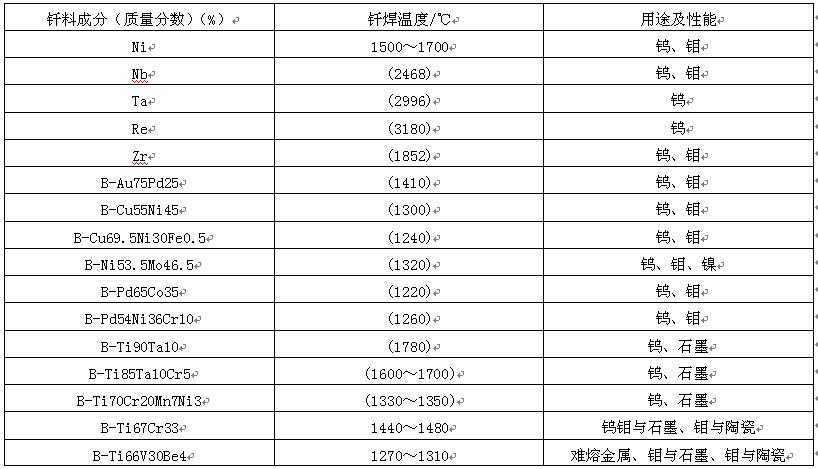1. Solder
All kinds of solders with temperature lower than 3000 ℃ can be used for W brazing, and copper or silver based solders can be used for components with temperature lower than 400 ℃; Gold based, manganese based, manganese based, palladium based or drill based filler metals are usually used for components used between 400 ℃ and 900 ℃; For components used above 1000 ℃, pure metals such as Nb, Ta, Ni, Pt, PD and Mo are mostly used. The working temperature of components brazed with platinum base solder has reached 2150 ℃. If 1080 ℃ diffusion treatment is carried out after brazing, the maximum working temperature can reach 3038 ℃.
Most of the solders used for brazing w can be used for brazing Mo, and copper or silver based solders can be used for Mo components working below 400 ℃; For electronic devices and non structural parts operating at 400 ~ 650 ℃, Cu Ag, Au Ni, PD Ni or Cu Ni solders can be used; Titanium based or other pure metal filler metals with high melting points can be used for components working at higher temperatures. It should be noted that manganese based, cobalt based and nickel based filler metals are generally not recommended to avoid the formation of brittle intermetallic compounds in the brazing joints.
When TA or Nb components are used below 1000 ℃, copper based, manganese based, cobalt based, titanium based, nickel based, gold based and palladium based injections can be selected, including Cu Au, Au Ni, PD Ni and Pt Au_ Ni and Cu Sn solders have good wettability to TA and Nb, good brazing seam forming and high joint strength. As silver based filler metals tend to make brazing metals brittle, they should be avoided as much as possible. For components used between 1000 ℃ and 1300 ℃, pure metals Ti, V, Zr or alloys based on these metals that form infinite solid and liquid with them shall be selected as brazing filler metals. When the service temperature is higher, the filler metal containing HF can be selected.
W. See table 13 for brazing filler metals for Mo, Ta and Nb at high temperature.
Table 13 brazing filler metals for high temperature brazing of refractory metals
Before brazing, it is required to carefully remove the oxide on the surface of refractory metal. Mechanical grinding, sand blasting, ultrasonic cleaning or chemical cleaning can be used. Brazing shall be carried out immediately after the cleaning process.
Due to the inherent brittleness of W, w parts shall be handled carefully in the component assembly operation to avoid breakage. In order to prevent the formation of brittle tungsten carbide, direct contact between W and graphite should be avoided. Prestressing due to pre welding processing or welding shall be eliminated before welding. W is very easy to oxidize when the temperature rises. The vacuum degree shall be high enough during brazing. When brazing is carried out within the temperature range of 1000 ~ 1400 ℃, the vacuum degree shall not be less than 8 × 10-3Pa。 In order to improve the remelting temperature and service temperature of the joint, the brazing process can be combined with the diffusion treatment after welding. For example, b-ni68cr20si10fel solder is used to braze W at 1180 ℃. After three diffusion treatments of 1070 ℃ /4h, 1200 ℃ /3.5h and 1300 ℃ /2h after welding, the service temperature of the brazed joint can reach more than 2200 ℃.
The small coefficient of thermal expansion should be taken into account when assembling the brazed joint of Mo, and the joint gap should be within the range of 0.05 ~ 0.13MM. If a fixture is used, select a material with a small coefficient of thermal expansion. Mo recrystallization occurs when flame brazing, controlled atmosphere furnace, vacuum furnace, induction furnace and resistance heating exceed the recrystallization temperature or the recrystallization temperature decreases due to the diffusion of solder elements. Therefore, when the brazing temperature is close to the recrystallization temperature, the shorter the brazing time, the better. When brazing above the recrystallization temperature of Mo, the brazing time and cooling rate must be controlled to avoid cracking caused by too fast cooling. When oxyacetylene flame brazing is used, it is ideal to use mixed flux, that is, industrial borate or silver brazing flux plus high-temperature flux containing calcium fluoride, which can obtain good protection. The method is to first coat a layer of silver brazing flux on the surface of Mo, and then coat high-temperature flux. The silver brazing flux has activity in a lower temperature range, and the active temperature of high-temperature flux can reach 1427 ℃.
TA or Nb components are preferably brazed under vacuum, and the vacuum degree is not less than 1.33 × 10-2Pa. If brazing is carried out under the protection of inert gas, gas impurities such as carbon monoxide, ammonia, nitrogen and carbon dioxide must be strictly removed. When brazing or resistance brazing is carried out in air, special brazing filler metal and appropriate flux shall be used. In order to prevent TA or Nb from contacting with oxygen at high temperature, a layer of metallic copper or nickel can be plated on the surface and corresponding diffusion annealing treatment can be carried out.
Post time: Jun-13-2022

